
USS Galena was a wooden-hulled broadside ironclad built for the United States Navy during the American Civil War. The ship was initially assigned to the North Atlantic Blockading Squadron and supported Union forces during the Peninsula Campaign in 1862. She was damaged during the Battle of Drewry's Bluff because her armor was too thin to prevent Confederate shots from penetrating. Widely regarded as a failure, Galena was reconstructed without most of her armor in 1863 and transferred to the West Gulf Blockading Squadron in 1864. The ship participated in the Battle of Mobile Bay and the subsequent Siege of Fort Morgan in August. She was briefly transferred to the East Gulf Blockading Squadron in September before she was sent to Philadelphia, Pennsylvania for repairs in November.

Fort Pickens is a pentagonal historic United States military fort on Santa Rosa Island in the Pensacola, Florida, area. It is named after American Revolutionary War hero Andrew Pickens. It is the largest of four forts built to defend Pensacola Bay and its navy yard. The fort was completed in 1834 and was one of the few forts in the South that remained in Union hands throughout the American Civil War. It remained in use until 1947. Fort Pickens is included within the Gulf Islands National Seashore, and as such, is administered by the National Park Service.

USS Hartford, a sloop-of-war steamer, was the first ship of the United States Navy named for Hartford, the capital of Connecticut. Hartford served in several prominent campaigns in the American Civil War as the flagship of David G. Farragut, most notably the Battle of Mobile Bay in 1864. She survived until 1956, when she sank awaiting restoration at Norfolk, Virginia.

The Parrott rifle was a type of muzzle-loading rifled artillery weapon used extensively in the American Civil War.
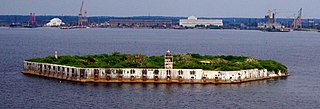
Fort Carroll is a 3.4-acre (1.4 ha) artificial island and abandoned hexagonal sea fort in the middle of the Patapsco River, just south of Baltimore, Maryland. It is named for Charles Carroll of Carrollton (1737–1832), a signer of the Declaration of Independence.
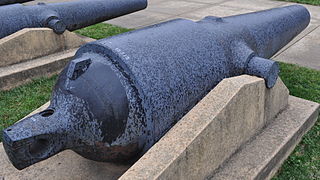
The Brooke rifle was a type of rifled, muzzle-loading naval and coast defense gun designed by John Mercer Brooke, an officer in the Confederate States Navy. They were produced by plants in Richmond, Virginia, and Selma, Alabama, between 1861 and 1865 during the American Civil War. They served afloat on Confederate ships and ashore in coast defense batteries operated by the Confederate States Army.

Field artillery in the American Civil War refers to the artillery weapons, equipment, and practices used by the Artillery branch to support the infantry and cavalry forces in the field. It does not include siege artillery, use of artillery in fixed fortifications, or coastal or naval artillery. Nor does it include smaller, specialized artillery classified as small arms.

Fort Adams is a former United States Army post in Newport, Rhode Island, that was established on July 4, 1799, as a First System coastal fortification, named for President John Adams, who was in office at the time. Its first commanding officer was Captain John Henry who was later instrumental in starting the War of 1812. The current Fort Adams was built between 1824 and 1857 under the Third System of coastal forts; it is part of Fort Adams State Park today.

The siege of Fort Pulaski concluded with the Battle of Fort Pulaski fought April 10–11, 1862, during the American Civil War. Union forces on Tybee Island and naval operations conducted a 112-day siege, then captured the Confederate-held Fort Pulaski after a 30-hour bombardment. The siege and battle are important for innovative use of rifled guns which made existing coastal defenses obsolete. The Union initiated large-scale amphibious operations under fire.
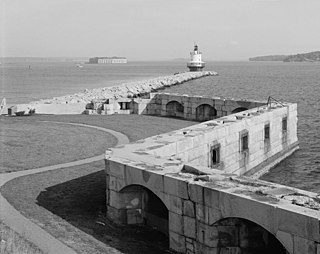
Fort Preble was a military fort in South Portland, Maine, United States, built in 1808 and progressively added to through 1906. The fort was active during all major wars from the War of 1812 through World War II. The fort was deactivated in 1950. It is now on the campus of Southern Maine Community College.
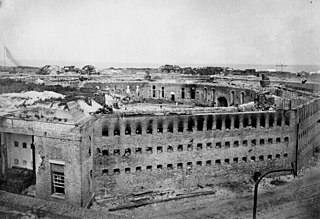
The siege of Fort Morgan occurred during the American Civil War, as part of the battle for Mobile Bay, in the Confederate state of Alabama during August 1864. Union ground forces led by General Gordon Granger conducted a short siege of the Confederate garrison at the mouth of Mobile Bay under the command of General Richard L. Page. The Confederate surrender helped shut down Mobile, Alabama, as an effective Confederate port city.

Siege artillery is heavy artillery primarily used in military attacks on fortified positions. At the time of the American Civil War, the U.S. Army classified its artillery into three types, depending on the gun's weight and intended use. Field artillery were light pieces that often traveled with the armies. Siege and garrison artillery were heavy pieces that could be used either in attacking or defending fortified places. Seacoast artillery were the heaviest pieces and were intended to be used in permanent fortifications along the seaboard. They were primarily designed to fire on attacking warships. The distinctions are somewhat arbitrary, as field, siege and garrison, and seacoast artillery were all used in various attacks and defenses of fortifications. This article will focus on the use of heavy artillery in the attack of fortified places during the American Civil War.
Fort Bowyer was a short-lived earthen and stockade fortification that the United States Army erected in 1813 on Mobile Point, near the mouth of Mobile Bay in what is now Baldwin County, Alabama, but then was part of the Mississippi Territory. The British twice attacked the fort during the War of 1812.
Blakely rifle or Blakely gun is the name of a series of rifled muzzle-loading cannon designed by British army officer Captain Theophilus Alexander Blakely in the 1850s and 1860s. Blakely was a pioneer in the banding and rifling of cannon but the British army declined to use Blakely's design. The guns were mostly sold to Russia and the Confederacy during the American Civil War. Blakely rifles were imported by the Confederacy in larger numbers than other Imported English cannon. The State of Massachusetts bought eight 9 in (23 cm) and four 11 in (28 cm) models.
The Monticello Artillery (1862–1865) was a Confederate Army artillery battery during the American Civil War. The unit was also known as: Owen's Battery, or Howell's Battery. Some post war records refer to the unit as the Drew Light Artillery because most original members were from Drew County, Arkansas.

The 3-inch ordnance rifle, model 1861 was a wrought iron muzzleloading rifled cannon that was adopted by the United States Army in 1861 and widely used in field artillery units during the American Civil War. It fired a 9.5 lb (4.3 kg) projectile to a distance of 1,830 yd (1,670 m) at an elevation of 5°. The 3-inch rifle was not as effective in firing canister shot as the heavier 12-pounder Napoleon, but it proved to be highly accurate at longer ranges when firing common shell or spherical case shot. There was only one reported case of a 3-inch ordnance rifle bursting in action. This was in stark contrast to the similarly-sized cast iron 10-pounder Parrott rifles which occasionally burst without warning, inflicting injury on the gun crews. The Confederate States of America lacked the technology to manufacture reliable copies of the 3-inch ordnance rifle. However, the Confederate States Army respected the weapons and employed those captured from Federal forces.

The 10-pounder Parrott rifle, Model 1861 was a muzzle-loading rifled cannon made of cast iron that was adopted by the United States Army in 1861 and often used in field artillery units during the American Civil War. Like other Parrott rifles, the gun breech was reinforced by a distinctive band made of wrought iron. The 10-pounder Parrott rifle was capable of firing shell, shrapnel shell, canister shot, or solid shot. Midway through the war, the Federal government discontinued the 2.9 in (74 mm) version in favor of a 3.0 in (76 mm) version. Despite the reinforcing band, the guns occasionally burst without warning, which endangered the gun crews. The Confederate States of America manufactured a number of successful copies of the gun.

The 20-pounder Parrott rifle, Model 1861 was a cast iron muzzle-loading rifled cannon that was adopted by the United States Army in 1861 and employed in field artillery units during the American Civil War. As with other Parrott rifles, the gun breech was reinforced by a distinctive wrought iron reinforcing band. The gun fired a 20 lb (9.1 kg) projectile to a distance of 1,900 yd (1,737 m) at an elevation of 5°. The 20-pounder Parrott rifle could fire shell, shrapnel shell, canister shot, and more rarely solid shot. In spite of the reinforcing band, the 20-pounder earned a dubious reputation for bursting without warning, killing or injuring gunners. The Confederate States of America also manufactured copies of the gun.

Cogswell's Battery Illinois Light Artillery was an artillery battery from Illinois that served in the Union Army during the American Civil War. Organized in November 1861 as Company A, 53rd Illinois Infantry Regiment, it was detached as an independent artillery battery in March 1862. The battery participated in the Siege of Corinth in May 1862. The unit remained near Memphis, Tennessee until June 1863 when it was ordered to reinforce the Siege of Vicksburg. Cogswell's Battery took part in the Jackson Expedition, the Missionary Ridge and in the Knoxville campaign in 1863. After performing garrison duty for most of 1864, the unit fought at Nashville in December. In spring 1865, the battery fought at Spanish Fort and Fort Blakeley during operations against Mobile, Alabama. The battery was mustered out in August 1865.
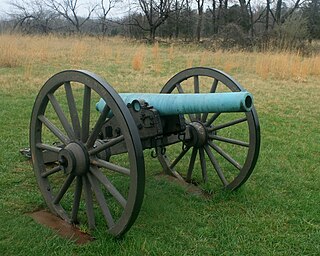
The 14-pounder James rifle or James rifled 6-pounder or 3.8-inch James rifle was a bronze muzzle-loading rifled cannon that was employed by the United States Army and the Confederate States Army during the American Civil War. It fired a 14 lb (6.4 kg) solid shot up to a distance of 1,530 yd (1,400 m) at 5° elevation. It could also fire canister shot and common shell. Shortly before the war broke out, the U.S. Army adopted a plan to convert M1841 6-pounder field guns from smoothbore to rifled artillery. Rifling the existing 6-pounders would both improve the gun's accuracy and increase the weight of the shell. There were two major types produced, both were bronze with a bore (caliber) of 3.8 in (97 mm) that would accommodate ammunition designed by Charles Tillinghast James. The first type looked exactly like an M1841 6-pounder field gun. The second type had a longer tube with a smooth exterior profile similar to a 3-inch Ordnance rifle. At first the rifles were quite accurate. However, it was discovered that the bronze rifling quickly wore out and accuracy declined. None of the rifles were manufactured after 1862, and many were withdrawn from service, though some artillery units employed the guns until the end of the war.




























